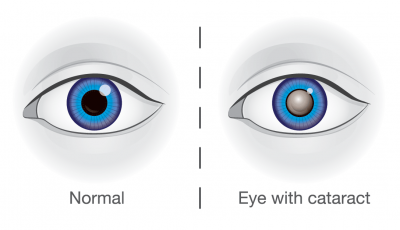About Cataracts
A cataract is a clouding of the eye’s natural lens, which lies behind the iris and the pupil. Cataracts are the most common cause of vision loss in people over age 40 and is the principal cause of blindness in the world. In fact, there are more cases of cataracts worldwide than there are of glaucoma, macular degeneration and diabetic retinopathy combined, according to Prevent Blindness America (PBA).
To learn more about cataract surgery, click on the links below:
 Cataracts are commonly associated with age; however, you don’t have to be a senior citizen to have cataracts. They can start developing after 40, although usually at this stage they are not serious enough to have a significant effect on your vision. The surgical method for cataracts is similar to the procedure used to treat Presbyopia.
Cataracts are commonly associated with age; however, you don’t have to be a senior citizen to have cataracts. They can start developing after 40, although usually at this stage they are not serious enough to have a significant effect on your vision. The surgical method for cataracts is similar to the procedure used to treat Presbyopia.
The term “cataracts” comes from a Latin word meaning “waterfall” and describes the whitening or cloudy effect of rushing water. The eye’s lens is made mostly of water and protein. In a healthy lens, the protein is normally clear and permits light to pass through. As we age, the protein can clump and begin to cloud a small section of the lens. This is a cataract. Over time, the cataract may grow larger and cloud more of the lens, making it harder and harder to see.
Symptoms of Cataracts
A cataract starts out small and at first has little effect on your vision. You may notice that your vision is blurred, like looking through a cloudy piece of glass or viewing an impressionist painting. In the early stages, one sees colors less vibrantly. In the later stages, the lens becomes almost opaque and has to be replaced with a clear, artificial lens. This procedure is called refractive lens exchange.
The type of cataract you have will affect exactly which symptoms you experience and how soon they will occur.
- Blurred or cloudy vision
- Colors appear faded or dull
- Lamps such as headlights or streetlights have glare or halos; sunlight may appear too bright
- Poor night vision
- Double or multiple vision in one eye; this effect may disappear as the Cataract grows
- Frequent prescription changes in your eyeglasses or contact lenses
What Causes Cataracts?
- Aging
- Diabetes
- Long-term exposure to ultraviolet light
- Exposure to radiation
- Hypertension
- Smoking
- Alcohol abuse
- Eye injuries
- Genetic factors–a parent or grandparent who had cataracts
Types of Cataracts
- Subcapsular Cataract: occurs at the back of the lens. People with diabetes or those taking high doses of steroid medications have a greater risk of developing a subcapsular cataract.
- Nuclear Cataract: forms deep in the central zone or nucleus of the lens. Nuclear cataracts usually are associated with aging.
- Cortical Cataract: is characterized by white, wedge-like opacities that start in the periphery of the lens and work their way to the center in a spoke-like fashion. This type of cataract occurs in the lens cortex, which is the part of the lens that surrounds the central nucleus.
Cataracts are one of many eye conditions diagnosed and treated by the capable doctors at Atlanta Eye Care and Windward Eye Care. With their help, you will be able to see the beauty all around you. Visit one of their offices conveniently located on Windward Parkway and Milton Parkway in Alpharetta. If you or a family member need an eye exam or a suffer from an eye condition, call for an appointment today.


